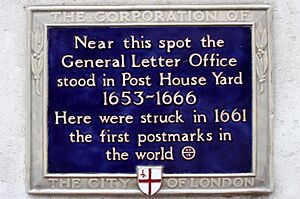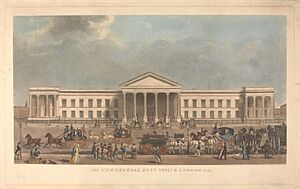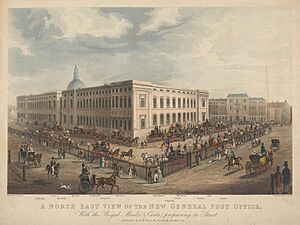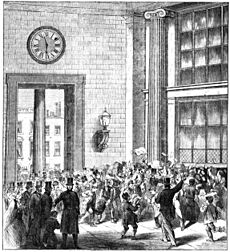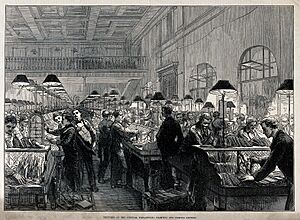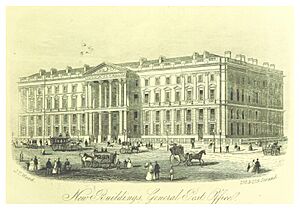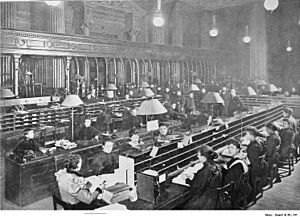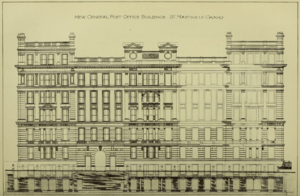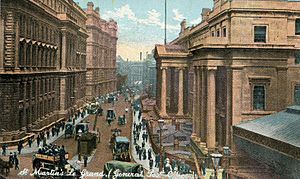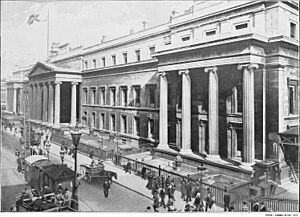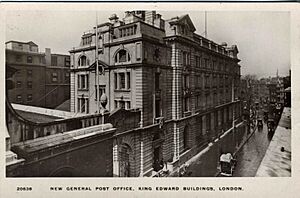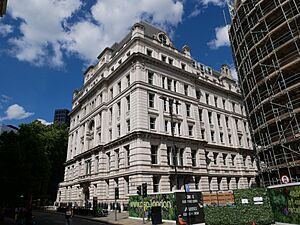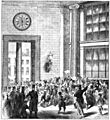General Post Office, London facts for kids
Quick facts for kids General Post Office |
|
|---|---|
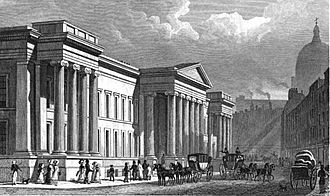
The 19th-century headquarters of the General Post Office in London
|
|
| General information | |
| Architectural style | Greek Revival |
| Address | St. Martin's Le Grand |
| Town or city | London |
| Country | United Kingdom of Great Britain and Ireland |
| Coordinates | 51°30′56″N 0°05′49″W / 51.515550°N 0.096925°W |
| Construction started | May 1824 |
| Opened | 23 September 1829 |
| Demolished | 1912 |
| Client | General Post Office |
| Dimensions | |
| Other dimensions | 400 feet (120 m) long, 80 feet (24 m) deep |
| Design and construction | |
| Architect | Robert Smirke |
The General Post Office (GPO) in St. Martin's Le Grand was London's main post office from 1829 to 1910. It was also the main office for the General Post Office of the United Kingdom of Great Britain and Ireland. This building was special because it was England's first post office built just for that purpose.
Before this, the GPO's main office, first called the General Letter Office, had been in the City of London since the 1600s. For 150 years, it was located on Lombard Street. Then, a new building was designed by Robert Smirke. It opened in 1829 on the east side of St. Martin's Le Grand. This new GPO building was not just a post office and sorting office. It also held the main offices for the Postmaster General of the United Kingdom and other important leaders.
Even though Smirke's General Post Office looked great from the outside, it had problems inside. It quickly became too small as more and more people used its services. By the late 1800s, the GPO had to spread out into other buildings nearby. After a new building opened on King Edward Street, Smirke's General Post Office was taken down in 1912.
Contents
Early Postal Services in London
Before the General Post Office was officially set up, there were "post houses" in London. These places provided horses for people carrying messages for the royal court. By the mid-1600s, London had separate post houses for each main "post road." These roads led from London to different parts of the country. For example, there was one in Bishopsgate Street for the route to Edinburgh. These post houses were usually connected to inns, where horses were kept.
Around 1653, a main "General Letter Office" was created. It was at the "Old Post House" near Threadneedle Street. This was a large building with offices and living spaces for Post Office workers. However, it was destroyed in the Great Fire of London in 1666. After the fire, the Post Office moved to several temporary locations.
The Lombard Street Post Office
In 1678, the General Post Office found a more lasting home. It moved into a large house on Lombard Street. The Post Office first rented this building and then bought it in 1705.
The Lombard Street Post Office was built around a courtyard. People could enter this courtyard from the street through a big gate. The sorting office was across the courtyard from the gate. The foreign letter office was on the left, and the main meeting room was on the right. Many clerks and staff also lived in the building. They had to be ready to work whenever the mail arrived, day or night.
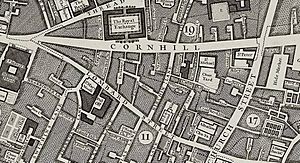
Over time, the Post Office in Lombard Street grew bigger. It expanded into nearby buildings. It stayed there for 150 years. But by the late 1700s, more and more mail coaches were being used. These coaches had trouble pulling up to the building because the street was too narrow.
Because the old building was too small, a new location was needed. In 1815, a law was passed to find a suitable spot. A piece of land on the east side of St. Martin's Le Grand was chosen. It took several years to clear the busy area. The new building's construction finally began in May 1824.
The St Martin's Le Grand Post Office
Smirke's new General Post Office opened on September 23, 1829. It was the second post office in the UK built specifically for that purpose. Dublin's GPO was finished in 1818 and is still in use today. The London Post Office was one of the biggest public buildings in the City of London at that time.
Building Design and Daily Work
The Post Office was built in the Greek style. It had grand Ionic porticoes (porches with columns) on its main front. The building was about 389 feet (118 meters) long, 130 feet (40 meters) wide, and 64 feet (20 meters) high. It was made of brick but covered in Portland stone. The main entrance had a large clock that helped keep time for everyone inside.
Mail Coaches and Carts
This GPO was built when mail coaches were very important. There was a driveway leading to a courtyard where coaches would gather. Every night, mail coaches from all over the country would leave at different times. They aimed to arrive at St Martin's Le Grand between 5 and 6 in the morning. The mail was then unloaded, sorted, and ready for delivery by 8 am. In the evening, coaches were loaded with mail for other towns.
The daily departure of the mail coaches was a popular event. From Monday to Saturday at 8 pm, all the coaches would leave St Martin's Le Grand. Each coach followed its own route, dropping off mail bags at every post town. Mail for other countries usually went to Falmouth or Dover to be put on packet boats.
During the day, red mail carts moved around, collecting and delivering mail within London. Young "riding-boys," usually 13 to 16 years old, also carried mail on horseback. These boys often became mail cart drivers when they were older. The carts and riding-boys collected mail from "receiving houses" all over London. By 1850, central London had ten collections and deliveries a day, six days a week. There were no deliveries or collections on Sundays.
The Grand Public Hall
Behind the main entrance was a large "Grand Public Hall." This hall was a public walkway from St Martin's-le-Grand to Foster Lane. It was 80 feet (24 meters) by 60 feet (18 meters) and had columns along the sides. People could post letters and other items through slots in the wall. These items would fall into trolleys and be taken to the sorting offices. There were also windows for making payments.
Every day, just before 6 pm (the deadline for mail), there was a big rush of people posting letters and newspapers. The slots would open wider to help, but they always closed exactly at 6 pm. After that, you could still post items at a "late" window, but you had to pay extra. The famous writer Charles Dickens wrote a detailed article about this daily rush in 1850.
The Grand Public Hall split the building into two parts. The south side handled London mail, and the north side handled mail for the rest of the country. A tunnel and conveyor system under the hall connected these two parts.
Main Offices
In 1829, the General Post Office had three main sections:
- The Inland Office: This handled letters between London and other towns across the UK and the British Empire.
- The Foreign Office: This managed letters to and from other countries.
- The London District Office: This was for sending letters within the London area.
The Inland Office
The Inland Office was in the northern part of the building. Here, large halls were used for sorting and sending mail. The biggest was the Inland Letter Office.
The Inland Letter Office was a large room, 90 feet (27 meters) by 56 feet (17 meters). Letters from and to other parts of the country were received, stamped, counted, and sorted here. It was very busy in the morning when coaches arrived with letters for London. It was also busy in the evening when London letters were sorted and loaded onto coaches.
Next to the Inland Letter Office was the Letter-carriers' Office. It was 103 feet (31 meters) by 35 feet (11 meters) and had iron galleries and spiral staircases. Each morning, letter-carriers sorted their letters into different delivery routes before leaving. In the evening, this office was used to sort many newspapers for overnight delivery.
Mail bags were received and sent from a large entrance on the east side. Before leaving the building, they were given to "Mail-Guards." These guards were armed and traveled with the mail on coaches to keep it safe.
Other rooms in this part of the building included the Dead Letter Office (for mail that couldn't be delivered) and the Blind Office (for reading unclear addresses).
The Foreign Office
The Foreign Letter Office was on the south side of the building. It sent letters to many overseas places using the packet service (government-owned ships). Its clerks often stayed overnight in the building. This was so they could be ready when letters arrived from other countries, day or night.
The London District Office
Also on the south side were the offices for the London District Office. This office handled mail within the London area. Its sorting office was much smaller than the Inland Office's.
The London District Office had its own entrance for mail carts and riding-boys. It also had stables for a few horses. This office worked constantly, receiving and sending letters throughout the day. Letters went out in sealed bags to "receiving houses" across London.
Other Important Offices
Other offices included the Receiver General and Accountant General, who handled money. The poste restante office, where people could pick up their mail, was also there. The Secretary of the Post Office, who was the main leader, had an office and a home in the building.
Changes and Improvements
Soon after it opened, the building was already running out of space.
1830s and 1840s
By 1831, an extra floor was added to the main Inland sorting office to create more room. In 1836, the Secretary's home in the building was turned into offices.
Within ten years, trains replaced mail coaches as the main way to send mail across the country. The Inland Office then used horse-drawn mail vans to take mail bags to railway stations. There, the mail was loaded onto trains or special Travelling Post Offices (trains where mail was sorted on the go).
When the uniform penny post started in 1840, the number of letters exploded. To handle this, a new sorting office was built right above the old one. A system with "endless chains" was also installed. These chains, powered by a steam engine, carried shelves with men and mail bags to different parts of the building.
The Money Order Office, which handled money transfers, also grew quickly. It moved to a new building across the road in 1846. The Foreign Letter Office was also combined with the Inland Letter Office. This created a new sorting office for "Colonial and Foreign" mail. The London District office then expanded into the space left by the Foreign Office.
1850s and 1860s
In the 1850s, London was divided into ten postal districts. Each district got its own office to sort and deliver mail. This helped ease the crowding at St Martin's Le Grand.
However, the Post Office's work kept growing. By 1860, the building was still very crowded. Rooms were packed, and even closets were used as offices. Poor ventilation and gas lighting made workers feel sick.
In 1870, the Grand Public Hall was closed and turned into another sorting room. People then posted their letters through slots under the main entrance.
New Post Office Buildings
GPO West
In 1874, a new building called GPO West opened on the western side of St. Martin's Le Grand. It was meant for the main offices and the Post Office Savings Bank. But after the UK's electrical telegraph companies became government-owned in 1870, the upper floors were used for telegraph equipment. This building became known as the Central Telegraph Office (CTO). Nearly a thousand people worked there, sending and receiving messages.
The CTO used wire connections and a network of pneumatic tubes to link to 38 other offices in central London. Three steam engines powered this system. GPO West kept growing, adding more space and another floor. By 1892, it was said to be the largest telegraph station in the world. In 1896, the GPO's new Telephone section also moved into GPO West.
GPO South
In 1880, a new building opened on Queen Victoria Street. It first housed the Post Office Central Savings Bank. Later, this building, called GPO South, became London's first telephone exchange and offices for the GPO's London Telephone Service.
GPO North
In 1895, GPO North opened just north of GPO West. It was connected by a bridge. This building, known as Post Office Headquarters (PHQ), was designed to hold the Postmaster General and the GPO's main administrative departments. To build it, an old inn called the Bull and Mouth Inn was torn down. This inn was where mail coaches used to get ready.
The building had a large courtyard in the middle. The Postmaster General had his office on the ground floor. The Permanent Secretary and his staff were on the first floor. A large basement under the courtyard held the Post Office's old records.
The Original GPO Building (GPO East)
Meanwhile, Robert Smirke's original General Post Office was renamed GPO East. It continued to handle letters and newspapers. When parcel post started in 1882, a sorting office for it was built in the basement. Later, in 1889, the parcel-post sorting office moved to Mount Pleasant. In 1893, an extra floor was added to GPO East.
However, a report in 1896 said the building was "uncomfortable, unhealthy, and overcrowded." The next year, it was decided to rebuild the inside of the building. To do this, the Inland and Newspaper sections moved to a new building at Mount Pleasant in 1900. GPO East then focused only on sorting London and foreign mail.
In 1900, the Central London Railway opened. The closest station to St. Martin's Le Grand was called Post Office. It was later renamed St Paul's in 1937.
Demolition and Replacement
In 1905, King Edward VII laid the foundation stone for a new building. This building was on King Edward Street, west of GPO North. It opened as the King Edward Building (KEB) in 1910. It was meant to replace Smirke's GPO East. It would house the main sorting offices for London and the Foreign Section. It would also be London's main public post office.
With the new King Edward Building open, the original Smirke building (GPO East) closed in 1910. Two years later, it was torn down. There were plans to build a new "GPO East" on the site for the growing administrative staff. But these plans never happened, and the land was sold in 1923.
What Happened Next
The St Martin's Le Grand area remained a key place for London's postal services for many years. In 1969, the General Post Office became The Post Office. It changed from a government department to a public company.
In the 1920s, new office buildings were built on the site of Smirke's demolished GPO East. These were rented to banks and other companies. After being damaged in World War II, two of these buildings were rented by the GPO in 1947. They remained in Post Office use until the late 1980s.
GPO West continued as the Central Telegraph Office. It was damaged during both World War I and World War II but was repaired. In 1962, the Central Telegraph Office moved. GPO West was later torn down in 1967. Today, BT Centre (the former headquarters of BT Group) stands on this site. A plaque there notes that Guglielmo Marconi made the first public wireless signal transmission from this spot in 1896.
GPO South, which became a telephone exchange, kept expanding. It was rebuilt in 1933 and is now known as the Faraday Building.
GPO North remained the Post Office Headquarters until 1984. The building was then sold to Nomura Holdings. They rebuilt the inside, but kept the old outside walls. It was renamed Nomura House.
The King Edward Building was used until the mid-1990s. From 1927, it was connected to the Post Office Railway. This underground railway transported mail between different sorting offices. The KEB offered a public counter service 24 hours a day for many years. It closed to the public in April 1994. It then continued as the Royal Mail City and International Office until 1996. The National Postal Museum, which opened in the building in 1966, also closed in 1996. The building was sold the next year.
Not everyone wanted Smirke's 1829 General Post Office to be torn down. There were ideas to save parts of it and rebuild them elsewhere. However, these plans did not happen. Today, one of the only remaining pieces of the building is an Ionic capital (the top part of a column). This five-ton piece was given to Walthamstow Urban District Council. It is now in Vestry Road. Other column capitals from the building were used as flower pots in the gardens at Hyde Hall, Sawbridgeworth.
Images for kids


